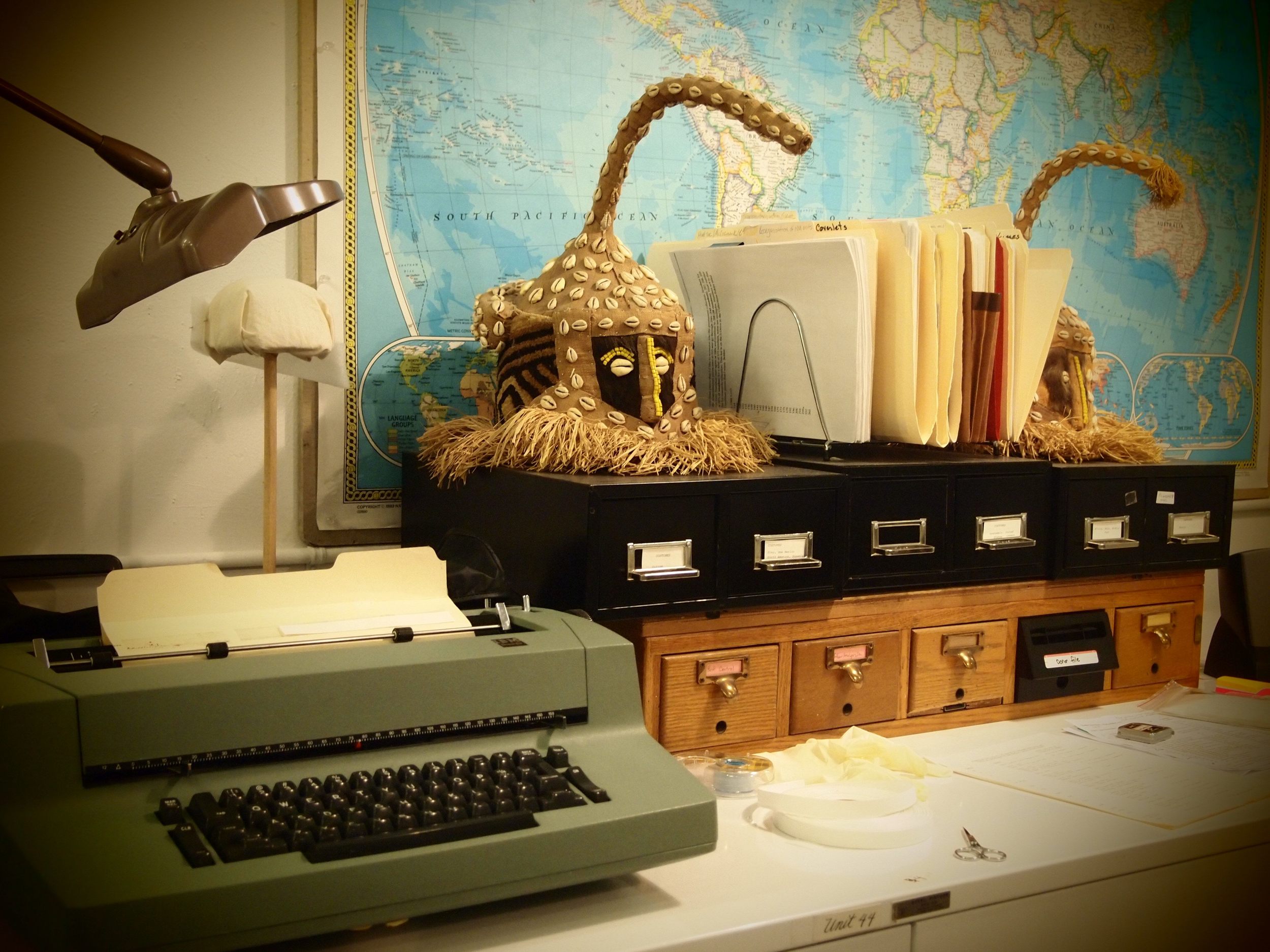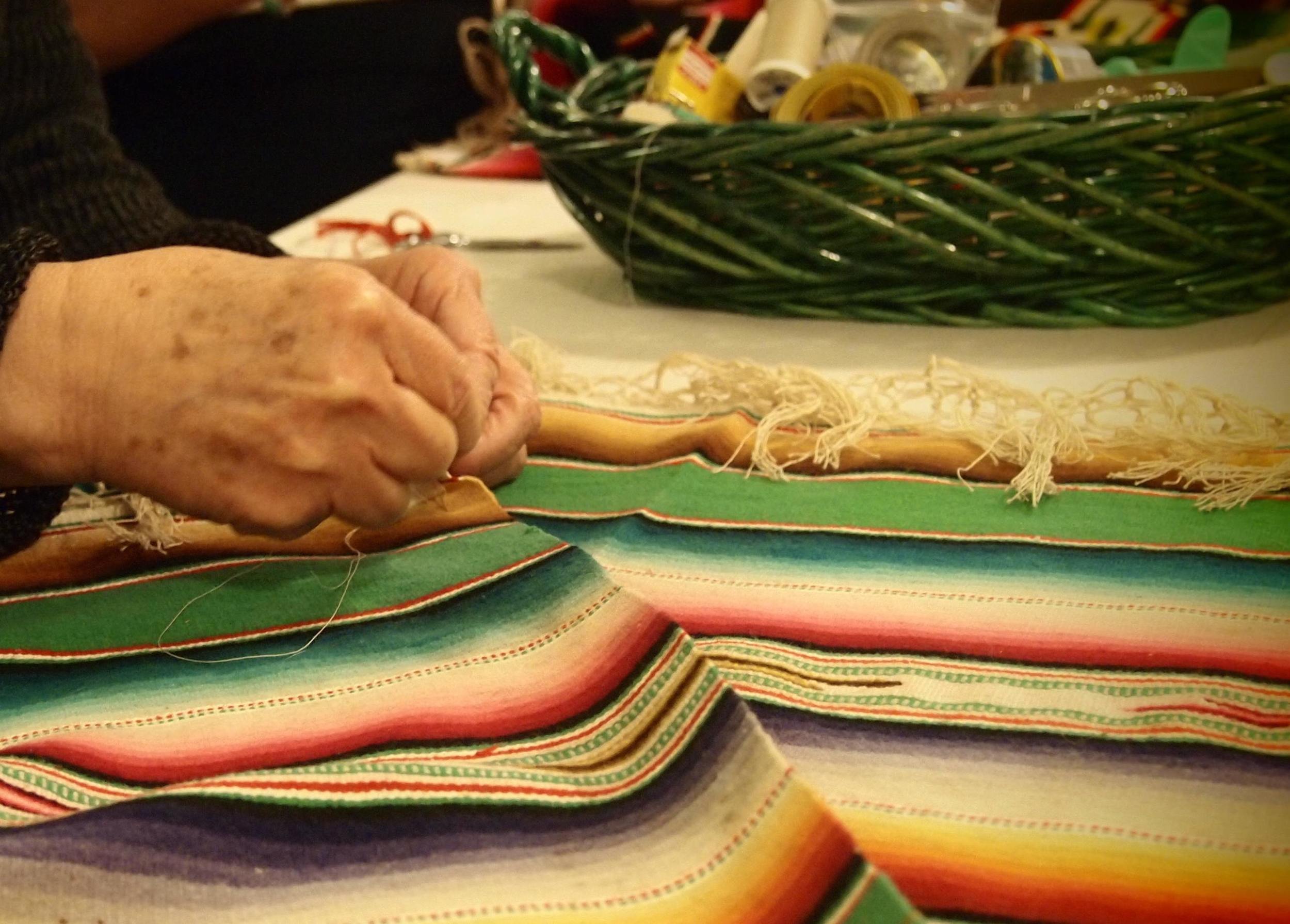Survivors: Textiles in the Museum of International Folk Art Collection—An Interview with Bobbie Sumberg
/by Mae Colburn
 A typewriter, two Kuba Masks from the Democratic Republic of Congo, and a world map in the Museum of International Folk Art textile collection room
A typewriter, two Kuba Masks from the Democratic Republic of Congo, and a world map in the Museum of International Folk Art textile collection room
“It’s my version of a protective amulet,” said textile curator Bobbie Sumberg of a poster taped to the back of the door in the Museum of International Folk Art’s textile collection room. The poster features color images of thirty-five bat species known to occur in the western United States, among them the pallid bat, a downy creature with a pink snout, striated ears, and delicate wings. “Bats eat insects,” she continued, “and insects eat textiles. It’s apotropaic.”
When I initially approached Bobbie about an interview, I proposed a conversation about the nexus between curation, fashion, and sustainability. Bats weren’t originally part of the agenda, but when we entered the collection, our discussion turned to textile storage, then to insects, and then logically to bats. Bobbie heads a textile collection of over 20,000 objects, so the fact that pest control is a priority comes as no surprise. The collection is housed in an expansive room below the museum. On one side are flat textiles, rolled so as to avoid wrinkles. On the other are shoes, garments, and headgear organized in closets and plastic containers. Jewelry and various other pieces are stored in drawers in the center of the room. A world map hangs on the far wall directly opposite Bobbie’s bat poster.
On the day that I visited the collection, Bobbie was working with two volunteers to label and catalog new acquisitions: a set of colorful Mexican Saltillo blankets and a Lybian robe donated to the museum by a former Peace Corps volunteer. “Is it kiddywampus?” asked one of the volunteers as she began rolling a Saltillo blanket. Bobbie turned to me and explained that handwoven textiles, which constitute the vast majority of collection, are rarely straight or flat. The collection is composed of pieces that were worn and used, produced with the dual purpose of form and function. Most of the objects in the collection were at one point exposed to some combination of heat, moisture, aridity, insects, animals, extreme wear, and the relentless human impulse to recut and repurpose. In this sense, the collection is composed of ‘survivors,’ textiles that individuals considered significant enough to keep, textiles from closets around the world.
 Volunteers sew tags onto newly acquired Mexican Saltillo Blankets
Volunteers sew tags onto newly acquired Mexican Saltillo Blankets
Bobbie Sumberg: When you ask somebody what [textiles] they have of their family, it’s often that people say “I’ve been carrying around my grandmother’s quilts for 30 years.” I ask, “Why do you carry those things around with you?” Because there’s a connection, a really strong connection with family, with tactile, with the idea of somebody creating something that literally keeps you warm, and figuratively keeps you warm. Not to make anything of this, but when I was a graduate student I did a proto-study with my family, which is a large family so I had a nice little focus group, and one of the questions was “What do you have that you keep and you don’t wear or don’t use?” And there are all kinds of reasons why people keep stuff, which I assumed was the case because when I looked at my own closet, it was the same thing. I had things that people made for me that I never wear. How could you get rid of something like that?
Mae Colburn: What you brought up about the closet, about keeping, is really interesting in the context of the museum because…
BS: Because we have 57 closets.
MC: There we were sitting amid one of the largest folk art collections in the United States discussing our closets, our personal collections. I asked Bobbie to provide some background on the museum collection, specifically on the distinction between ‘ethnic’ and ‘local’ dress versus ‘cosmopolitan’ fashion items, a distinction that Bobbie discussed in her most recent publication Textiles: Collection of the Museum of International Folk Art.
BS: The distinction comes from some work that I did as a graduate student with my major professor Joanne Eicher at the University of Minnesota. She was editing a volume called Dress and Ethnic Identity published by Berg publishers. There was a discussion in the field of clothing and textiles about terminology, and the use of ‘costume’ and the use of ‘western’ versus ‘nonwestern dress,’ and so it was her intention to create some terminology and some vocabulary that is both more accurate of the situation in the world and less pejorative.
To me the difference is that ‘ethnic’ or ‘local’ is really about what people wear that has developed in their specific context – environmental, geographical, cultural context – and usually has something to do with how they conceive of themselves both as an individual and as a member of a social cultural gender group. Cosmopolitan [dress] was produced much more by the fashion system. The other way that I characterize the collection is as things that people make for their own use.
 A card file drawer labeled “pest control” in the textile collection room.
A card file drawer labeled “pest control” in the textile collection room.
MC: I’d like to ask you about the collection as a whole – how it was formed – and about the exhibition that was mounted in 2003, Handmade Planet: Florence Dibell Bartlett’s Vision for the Museum of International Folk Art. I’m curious whether you could describe this vision.
BS: She was a fairly complex person from what I know about her and her life and her intentions. What she saw when she was traveling (she did a lot of traveling, she came from a very wealthy family) in the 1920s and 30s was that the artistry that people had to create what they used and needed in their lives was fast disappearing. So she collected what she thought of as disappearing arts in order to preserve them, and things that she perceived as being integral to the culture of wherever she was. Her idea in establishing the museum was that seeing and experiencing the art of the world would bring people together. How I kind of paraphrase it, and phrases that I’ve used a lot in conceptualizing things and talking to people is, ‘the particular in the universal.’ We all wear clothes. We all use an immense number of textiles in our lives, whether we are aware of it or not, and the urge to embellish is pretty universal, and yet it happens in a very particular context.
MC: I’m noticing an ongoing theme here: the Museum of International Folk Art, Handmade Planet, and then there’s Material World, the current exhibit. All of these have a global scope. To you, what are the distinct benefits of dealing with textiles and dress on this global context?
BS: I would go back to the idea of the particular in the universal because I think that people look at clothing and textiles, ‘dress’ as we call it, in really different ways. One of my goals is to help bring the idea of cloth to peoples’ consciousness. As I always say, we get dressed every day, but we don’t really think that much about the significance of what our choices are when it comes to the textiles that surround us. I think a lot of people don’t always see what surrounds them. It’s one of my goals to bring [textiles] up to a different level of consciousness.
MC: Just to tie up, do you have any closing thoughts about the topic that I approached you about initially – sustainability, curation, and fashion? How can a collection such as this be understood within the context of fashion and sustainability?
BS: Sometimes I think ‘why’? What are we doing? It’s so frivolous. It reaches so few people. And yet as a repository for techniques, for instance, that in two generations get lost – they can be recreated and relearned from the original pieces. That has been done in the past here at this museum particularly with northern New Mexico weavers, dyers, and embroiderers. The collection has been used to aid in the revival of some of the historic designs. And so there’s a lot of value in a collection like this just on that level: keeping things and keeping them available.
Mae Colburn is an independent textile researcher and writer and professional seamstress based in Santa Fe, New Mexico.
Bobbie Sumberg is curator of textiles and costume at the Museum of International Folk Art in Santa Fe, New Mexico. Previous exhibitions include Needles and Pins: Textiles and Tools and Power Dressing: Men's Fashion and Prestige in Africa. Her most recent exhibition, on view at the museum through August 2011, is titled Material World: Textiles and Dress from the Collection.





